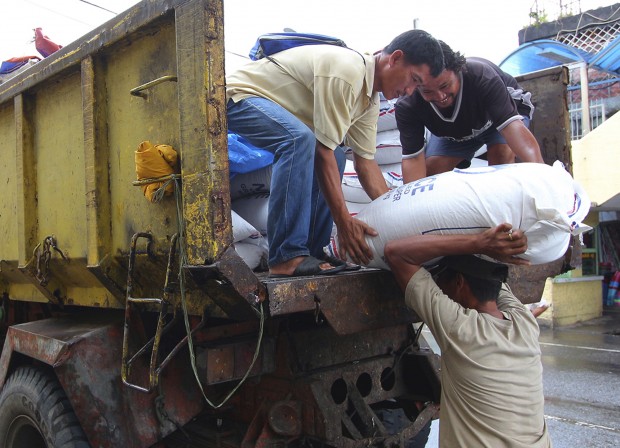
Workers unload sacks of rice intended for typhoon evacuees in Legazpi city, central Philippines as Typhoon ‘Nona’ (International name Melor) slammed into the eastern Philippines, Monday, Dec. 14, 2015. Hundreds of thousands of residents fled their homes as Typhoon Melor slammed into the eastern Philippines, where flood- and landslide-prone communities are bracing for destructive winds, heavy rains and coastal floods of up to 4 meters (13 feet), officials said Monday. (AP Photo/Roldano Amaranto)
TYPHOON “Nona” (international name Melor) has slowed down as it crosses northern Mindoro, the weather bureau said Tuesday afternoon.
The typhoon moved slowly westward at 11 kilometers per hour, the Philippine Atmospheric, Geophysical and Astronomical Services Administration (Pagasa) said.
According to Pagasa, storm signals were hoisted in the following areas:
Signal No. 3
Oriental Mindoro and Occidental Mindoro including Lubang Island
Signal No. 2
Batangas, Cavite, Marinduque, Romblon and Calamian group of Islands
Signal No. 1
Metro Manila, Bataan, Southern Zambales, Bulacan, Laguna, Rizal, Quezon and Northern Palawan including Cuyo Island
Nona is still in the Philippine landmass but it will traverse the West Philippine Sea Tuesday night, Pagasa said.
The typhoon maintained its strength of 140 kilometers per hour near the center and gusts of up to 170 kph. It was last tracked in Santa, Cruz, Oriental Mindoro.
By Friday afternoon, it will exit the Philippine area of responsibility.
Moderate to heavy rains are forecast within the 250 kilometer radius of the typhoon.
Pagasa continued to warn of flashfloods, landslides and storm surges of up to 2 meters in areas under Signals No. 2 and 3.
The low pressure area being monitored by the state weather bureau was last observed 1,645 kilometers east southeast of Mindanao.